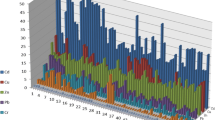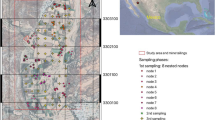Abstract
In 1996, the Tab-Simco site, an abandoned coal mine 10 km southeast of Carbondale, Illinois, was listed as one of the most highly contaminated AMD sites in the mid-continent region. A suite of impacted soil and water samples were collected from various locations to characterize the current extent of AMD pollution, following standard U.S. EPA protocols. The mean pH of soil and water samples were found to be 2.69 and 2.07, respectively. The mean sulfur content of the soil samples was 0.5 %. The AMD-impacted soils contained high concentrations of Fe, Zn, Ni, Cr, Cu, Pb, and As. The AMD also contained high concentrations of Fe, As, Zn, Pb, Cr, Al, Cd, Cu, and Ni, as well as \({\text{SO}}_{4}^{2 - }\), all of which were significantly above their U.S. EPA permissible limits for surface water.
Zusammenfassung
1996 wurde das Tab-Simco Areal, ein stillgelegtes Kohlebergwerk ca. 10 km südöstlich von Carbondale, Illinois, als eines der am stärksten durch saures Grubenwasser (AMD) kontaminierten Gebiete in den zentralen USA ausgewiesen. An verschiedenen Stellen wurden entsprechend den Standards der US-EPA Boden- und Wasserproben entnommen, um das aktuelle Ausmaß der Kontamination durch AMD zu erfassen. Der mittlere pH-Wert des Bodens lag bei 2,69 und der des Wassers 2,07. Der mittlere Schwefelgehalt des Bodens betrug 0,5%. Die durch AMD kontaminierten Böden hatten hohe Konzentrationen an Fe, Zn, Ni, Cr, Cu, Pb und As. Das saure Grubenwasser hatte hohe Konzentrationen an Fe, As, Zn, Pb, Cr, Al, Cd, Cu und Ni sowie SO42-, die alle signifikant über den zulässigen Grenzwerten der US-EPA für Oberflächengewässer lagen.
Resumen
En 1996, el sitio Tab-Simco, una mina de carbón abandonada que está ubicada 10 Km al sudeste de Carbondale, Illinois, fue listada como uno de los sitios más altamente contaminados por drenaje ácido de minas (AMD) en la región media continental. Muestras de aguas y de suelo impactado fueron colectada desde varios puntos del sitio para caracterizar la extensión actual de la polución por AMD, siguiendo protocolos estándar de U.S. EPA. Los valores promedio de pH en el suelo y en las muestras de agua fueron 2,69 y 2,07, respectivamente. El contenido promedio de azufre en el suelo fue 0,5%. Los suelos impactados por el AMD contenían altas concentraciones de Fe, Zn, Ni, Cr, Cu, Pb y As. El AMD también contenía altas concentraciones de Fe, As, Zn, Pb, Cr, Al, Cd, Cu y Ni, así como SO42-, todas significativamente superiores a los límites permitidos U.S. EPA para agua superficial.
摘要
Tab-Simco煤矿为伊利诺斯州(Illinois)卡本代尔(Carbondale)东南10km的废弃煤矿,1996年被列为中部大陆最严重酸性废水污染区之一。依照美国环保局标准协议,多点采集了受污染土样和水样,以研究AMD当前污染程度。土壤和水样的平均pH值分别为2.69和2.07。土样的平均硫含量为0.5%。AMD污染土样含有高浓度的Fe、Zn、Ni、Cr、Cu、Pb和As。AMD中同样也含有高浓度的Fe、As、Zn、Pb、Cr、Al、Cd、Cu、Ni及SO 2-4 ,都明显超过美国环保局地表水质界限。




Similar content being viewed by others
References
Behum PT, Kiser R, Lewis L (2010) Investigation of the acid mine drainage at the Tab-Simco mine, Carbondale, Illinois. In: Proceedings, 38th annual meeting of the National Association of State Land Reclamationists, Carbondale, IL
Behum PT, Lefticariu L, Bender KS, Segid YT, Burns AS, Pugh CW (2011) Remediation of coal-mine drainage by a sulfate-reducing bioreactor: a case study from the Illinois coal basin, USA. Appl Geochem 26:S162–S166. doi:10.1016/j.apgeochem.2011.03.093
Behum PT, Lewis L, Kiser R, Lefticariu L (2012) Remediation of acid mine drainage using sulfate-reducing bioreactors—case example: the Tab-Simco passive treatment system. In: Proceedings, National meeting of the American Society of Mining and Reclamation (ASMR), Tupelo, MS
Behum PT, Lefticariu L, Walter E, Kiser R (2013) Passive treatment of coal-mine drainage by a sulfate-reducing bioreactor in the Illinois coal basin. In: Proceedings, West Virginia Mine Drainage Task Force symposium, Morgantown, WV
Benner SG, Blowes DW, Ptacek CJ (1997) A full-scale porous reactive wall for prevention of acid mine drainage. Groundw Monit Remediat 17(4):99–107
Burns AS, Pugh CW, Segid YT, Behum PT, Lefticariu L, Bender KS (2012) Performance and microbial community dynamics of a sulfate-reducing bioreactor treating coal generated acid mine drainage. Biodegradation 23:415–429. doi:10.1007/s10532-011-9520-y
Ferguson KD, Erickson PM (1988) Pre-mine prediction of acid mine drainage. In: Salomons W, Forstner U (eds) Dredged material and mine tailings. Springer, Berlin, pp 24–43. doi:10.1007/978-3-642-61362-3_2
Gerhardt A, de Bisthoven LJ, Soares AMVM (2004) Macroinvertebrate response to acid mine drainage: community metrics and on-line behavioural toxicity bioassay. Environ Pollut 130(2):263–274
Hansen JA, Welsh PG, Lipton J, Cacela D (2002) Effects of copper exposure on growth and survival of juvenile bull trout. Trans Am Fish Soc 131(4):690–697
Jennings SR, Neuman DR, Blicker PS (2008) Acid mine drainage and effects on fish health and ecology: a review. Reclam Res Group Publ, Bozeman, MT. Retrieved from: http://reclamationresearch.net/publications/Final_Lit_Review_AMD.pdf
Kim AG, Heisey B, Kleinmann R, Duel M (1982) Acid mine drainage: control and abatement research. U.S. DOI, Bureau of Mines IC 8905, p 22
Lewis LL (2008) Addressing acid mine drainage from complex conditions at the Tab-Simco mine. In: Proceedings, 30th Annual National Association of Abandoned Mines Land Programs conference, Durango, CO, USA
Martin AJ, Goldblatt R (2007) Speciation, behavior, and bioavailability of copper downstream of a mine-impacted lake. Environ Toxicol Chem 26(12):2594–2603
Mills C (2014) Acid base accounting (ABA) test procedures. Retrieved from: http://technology.infomine.com/enviromine/ard/. Website accessed: 15 Dec 2014
North Carolina Administrative Code (2003) NC DENR—Division of water quality “Redbook” surface waters and wetlands standards. NC Administrative Code 15A NCAC 02B .0100 & .0200. Amended effective: 1 April 2003
Page AL, Miller RH, Keeney DR (1982) Methods of soil analysis: part 2—chemical and microbiological properties, 2nd edn. American Society of Agronomy, Soil Science Society of America, Madison, pp 199–209
Plumb Jr. RH (1981) Procedure for handling and chemical analysis of sediment and water samples. Tech. Rep. EPA/CE-81-1, prepared by Great lakes Laboratory. State Univ College at Buffalo, Buffalo, NY. Retrieved from: https://yosemite.epa.gov/r10/CLEANUP.NSF/ph/T4+Technical+Documents/$FILE/Plumb.pdf
Rhoades JD (1996) Salinity: electrical conductivity and total dissolved solids. In: Sparks DL, Page AL, Helmke PA, Loeppert RH (eds) Methods of soil analysis, part 3: chemical methods. SSSA book series, vol 5.3. Soil Science Society of America, Madison, pp 417–435. doi:10.2136/sssabookser5.3.c14
RoyChowdhury A, Sarkar D, Datta D (2015) Remediation of acid mine drainage-impacted water. Curr Pollution Rep 1:131–141. doi:10.1007/s40726-015-0011-3
Schmidt TS, Soucek DJ, Cherry DS (2002) Modification of an ecotoxicological rating to bioassess small acid mine drainage-impacted watersheds exclusive of benthic macroinvertebrate analysis. Environ Toxicol Chem 21(5):1091–1097
Segid YT (2010) Evaluation of the Tab-Simco acid mine drainage treatment system: water chemistry, performance and treatment processes. M.S. Thesis, Dept of Geology, Southern Illinois Univ, Carbondale, IL
Skousen J, Ziemkiewicz P (2005) Performance of 116 passive treatment systems for acid mine drainage. In: Proceedings, 2005 national meeting of the ASMR, Breckenridge, CO, pp 1100–1133
Smith PA (2002) Characterization of an acid mine drainage site in Southern Illinois. In: Proceedings, 19th annual national meeting of the ASMR, Lexington, KY, pp 472–486
Sobek AA, Schuller WA, Freeman JR, Smith RM (1978) Field and laboratory methods applicable to overburdens and minesoils (West Virginia Univ, Morgantown College of Agriculture and Forestry): U.S. Environmental Protection Agency, Cincinnati, Ohio. EPA-600/2-78-054, U.S. National Technical Information Service Report PB-280 495, pp 47–50
Soucek DJ, Cherry DS, Currie RJ, Latimer HA, Trent GC (2000) Laboratory and field validation in an integrative assessment of an acid mine drainage-impacted watershed. Environ Toxicol Chem 19(4):1036–1043
Trout Unlimited (2011) The west branch Susquehanna recovery benchmark project. Lock Haven, PA. Retrieved from: http://www.patrout.org/docs/reference-materials/west_branch_susquehanna_recovery.pdf?sfvrsn=2
U.S. EPA (1994a) Technical document: acid mine drainage prediction. EPA 530-R-94-036. NTIS PB94-201829
U.S. EPA (1994b) Methods for the chemical analysis of water and wastes. EPA/600/4-79/020, U.S. Environmental Protection Agency, Washington, DC
U.S. EPA (1994c) Water quality standards handbook, 2nd edn. EPA 823-B-94-005a, U.S. Environmental Protection Agency, Office of Science and Technology, Washington, DC
U.S. EPA (1996) Test methods for evaluating solid waste, SW 846, 3rd edn, U.S. Environmental Protection Agency, Office of Solid Waste and Emergency Response, Washington, DC
U.S. EPA (2011) Mining operation as nonpoint source pollution. Retrieved from: www.epa.gov
USDA Forest Service (1993) Acid mine drainage from mines on the National Forests, a management challenge. US Forest Serv Publ 1505:1–12
USDA Forest Service (2005) Wildland waters. Issue 4. FS-812. Retrieved from: http://www.fs.fed.us
Acknowledgments
The authors thank the United States Department of the Interior, Office of Surface Mining Reclamation and Enforcement for providing funding for this study (OMB No.: 4040-0004). ARC gratefully acknowledges the Assistantship offered to him by the Ph.D. Program in Environmental Management at Montclair State University. Assistance provided to ARC by Dr. Samuel Ma and Mathew Adler from the Southern Illinois University at Carbondale in collecting the soil and water samples from the Tab-Simco site is also acknowledged.
Author information
Authors and Affiliations
Corresponding author
Rights and permissions
About this article
Cite this article
RoyChowdhury, A., Sarkar, D., Deng, Y. et al. Assessment of Soil and Water Contamination at the Tab-Simco Coal Mine: A Case Study. Mine Water Environ 36, 248–254 (2017). https://doi.org/10.1007/s10230-016-0401-9
Received:
Accepted:
Published:
Issue Date:
DOI: https://doi.org/10.1007/s10230-016-0401-9




